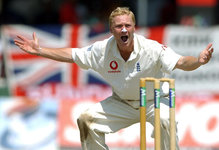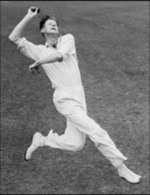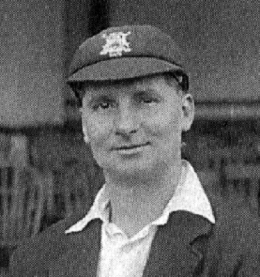My next pick
Nigel Haig
Stats | Matches | Runs | High Score | Batting Ave | 50s/100s | Wickets | BBI | BBM | Bowling Ave | Econ | 5w/10w |
|---|
First Class | 513 | 15,220 | 131 | 20.90 | 12/61 | 1,117 | 7/33 | ? | 27.48 | 2.35 | 47/2 |
Test | 5 | 126 | 47 | 14.00 | 0/0 | 13 | 3/73 | 4/122 | 34.46 | 2.61 | 0/0 |
From cricinfo:
"Nigel Haig was a celebrated amateur allrounder between the two World Wars. He did not gain a place in the XI while at Eton, but from 1912 until he retired from the game in 1934 he rendered splendid service to Middlesex, whom he captained for the last six years of his career. He was a member of the Championship-winning sides of 1920 and 1921. In addition, he played for England against Australia in the second of the disastrous Test series of 1921 and four times against the West Indies for the Hon. F. S. G. Calthorpe's M.C.C. team of 1929-30 without achieving much success. In all first-class cricket, Haig hit 15,208 runs, average 20.83, and with swing-bowling above medium pace he obtained 1,116 wickets for 27.47 runs each.
Six times he exceeded 1,000 runs, five times he took 100 or more wickets in a season and in 1921, 1927 and 1929 he did the cricketers' double. An agile fieldsman, he held 218 catches. His batting style was scarcely classic, but a quick eye stood him in good stead and, despite his not very powerful physique, he could hit the ball hard. The highest of his twelve centuries was 131 against Sussex at Lord's in 1920, when he, P. F. Warner, H. W. Lee and J. W. Hearne, the first four Middlesex batsmen, each reached three figures--an unprecedented occurrence in first-class cricket which was repeated for the same county by H. L. Dales, H. W. Lee, J. W. Hearne and E. Hendren against Hampshire at Southampton three years later.
Seemingly built of whipcord, Haig, a nephew of Lord Harris, bowled for long spells without apparent signs of fatigue. Among his best performances with the ball was the taking of seven wickets for 33 runs in the Kent first innings at Canterbury in 1920. This was another eventful match for Haig, for he scored 57 in the Middlesex first innings and became the second leg of a hat-trick by A. P. Freeman in the second. In 1924 Haig took six wickets for 11 runs in Gloucestershire's first innings on Packer's Ground at Bristol, a game rendered specially memorable by the fact that C. W. L. Parker, the slow left-hander, twice accomplished the hat-trick at the expense of Middlesex. Haig was also a fine real tennis player, could hold his own with lawn tennis players of near-Wimbledon standard and was equally good at racquets, squash and golf. While serving with the Royal Field Artillery during the First World War, he won the M.C.
Clarence Passailaigue was a close childhood friend of George Headley, who scored 183 on his first-class debut for Jamaica against MCC in 1929-30. His second match was his Test debut, also at Sabina Park, in the final Test where he made 44 and 2 not out, and he was unfortunate not to be picked for the tour of Australia in 1930-31. Indeed, it was rather odd that he never played for West Indies again. The remainder of his first-class career was spasmodic, with ten matches in the next eight years, all in either Jamaica or Trinidad. In 1931-32, he hammered a career-best 261 not out against Lord Tennyson's tourists, adding a world-record 487 for the sixth wicket with Headley."
- ?
- ?
- ?
- ?

 Charles Passailaigue
Charles Passailaigue- ?

 Nigel Haig
Nigel Haig- ?
- ?
- ?
- ?
Test caps used (6/50)
@blockerdave you have the next pick





